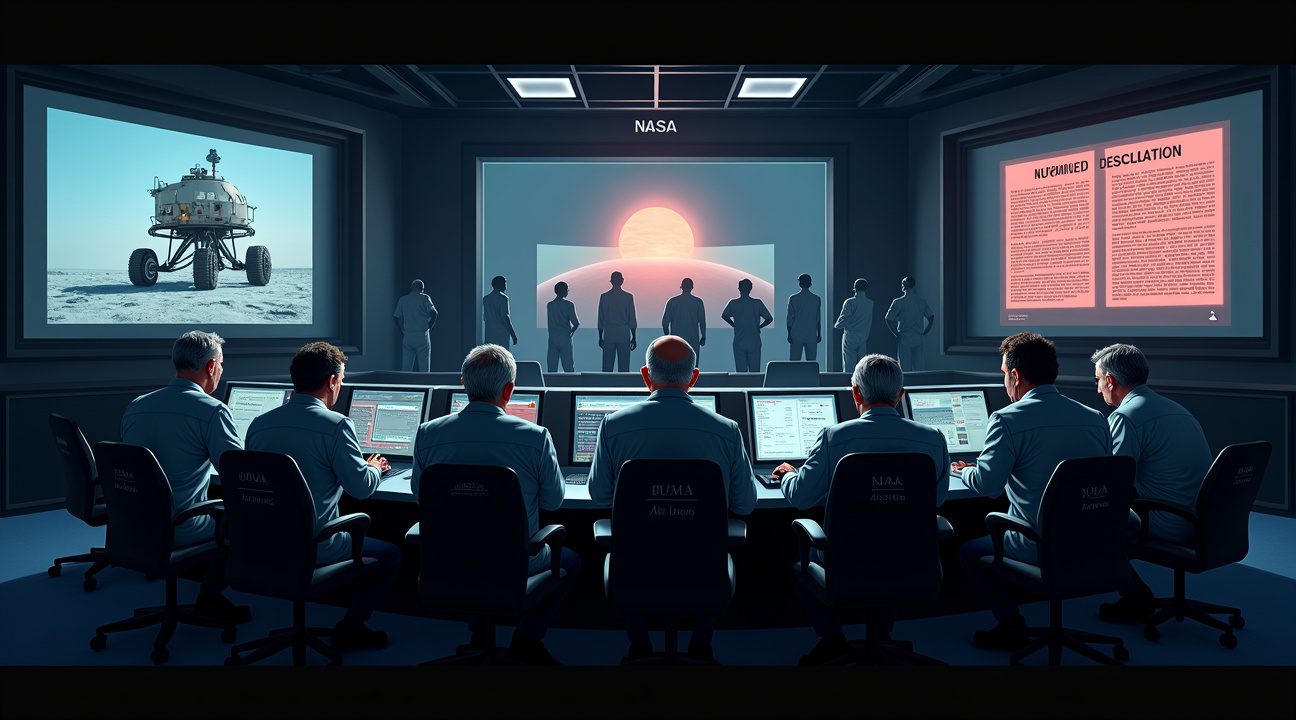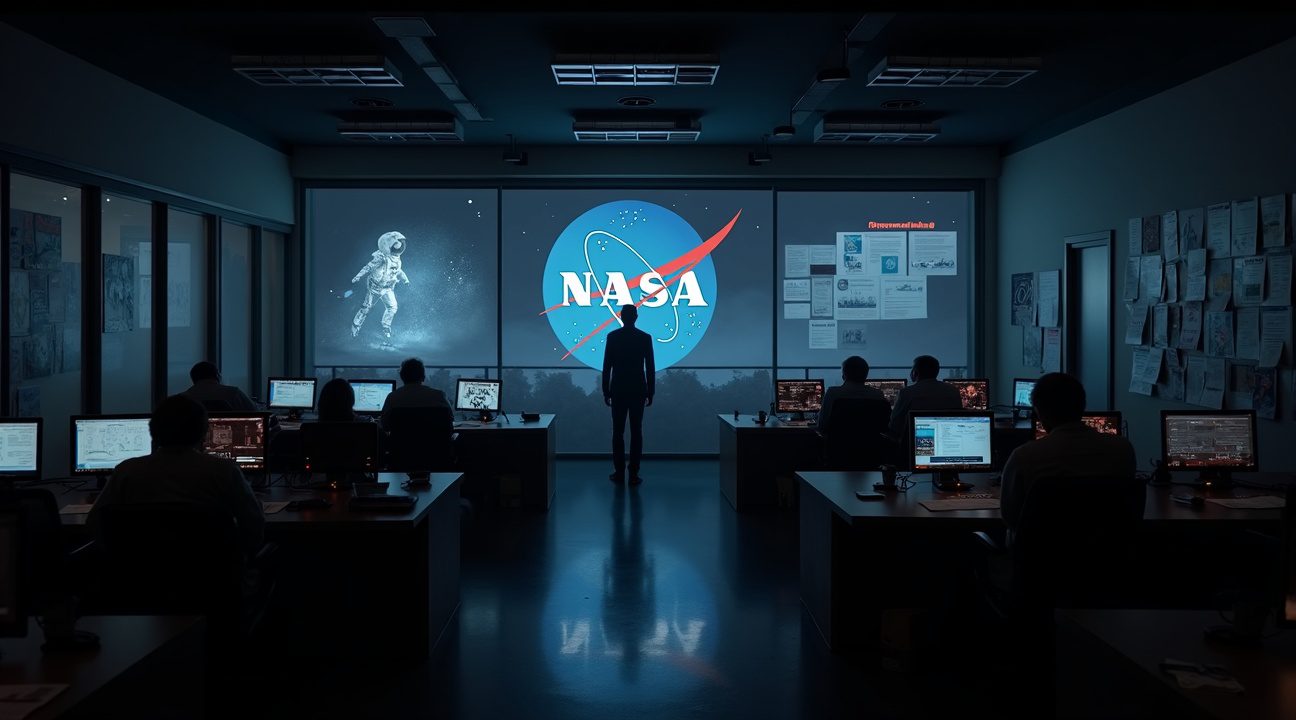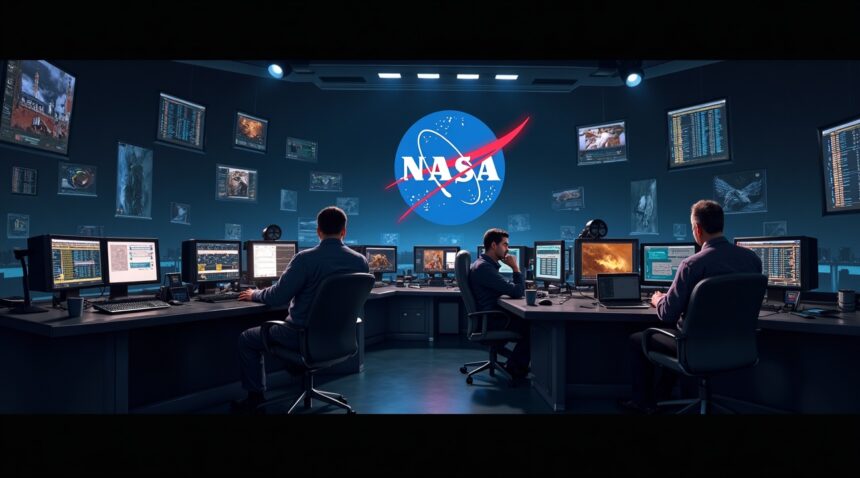NASA Faces Unprecedented Workforce Crisis Amid Budget Cuts and Leadership Gaps
NASA is grappling with a historic workforce shift as nearly 4,000 employees—more than 20% of its staff—seek departure under the Deferred Resignation Program (DRP), amid severe budget proposals and leadership instability that threaten the future of America’s space exploration efforts.
Key Takeaways
- Historic workforce reduction: Close to 4,000 employees have applied to exit through the DRP, dropping NASA’s staffing level from 18,000 to around 14,000—the biggest voluntary exodus in recent history.
- Safety concerns from scientists: The “Voyager Declaration,” signed by 362 current and former NASA employees, warned the abrupt loss of personnel and funding may compromise astronaut safety and scientific research.
- Leadership crisis compounds problems: With Jared Isaacman’s nomination withdrawn due to conflicts with Elon Musk, NASA remains under interim leadership, causing additional uncertainty for the workforce.
- Severe budget cuts target science programs: Proposed financial reductions for FY2026 may shrink NASA’s budget by up to 25%, slashing science program funds by as much as 50% in favor of crewed missions.
- Uneven impact across facilities: Centers like Goddard Space Flight Center could lose up to 18% of their staff, while others remain less affected, straining operational consistency across key programs.
Shifting Priorities and Budget Implications
NASA’s current situation represents more than personnel adjustments—it signals a possible transformation in America’s space exploration strategy. Veteran scientists and engineers committed to space advancement now face layoffs and morale challenges as political agendas and budgetary constraints take center stage.
Funding cuts appear aimed squarely at Earth science, astrophysics, and planetary science, while preserving capital for Artemis missions and Mars ventures. This realignment reflects evolving administration goals but risks undermining the agency’s longstanding scientific capabilities.
Uncertain Leadership Fuels Instability
Leadership voids add complexity, particularly after the withdrawal of Jared Isaacman’s nomination. Interim administrators must make impactful decisions in workforce policy, program direction, and public engagement without a long-term vision, further discouraging employee retention.
Loss of Experience Due to Deferred Resignation
The DRP attracted thousands of applications from seasoned professionals including scientists, mission controllers, and engineers. This sweeping departure risks leaving critical knowledge gaps during pivotal mission stages, such as the Mars Sample Return and lunar landings under the Artemis program.
Voyager Declaration Raises Alarm
The “Voyager Declaration” urges caution, highlighting how the internal expertise of NASA veterans is irreplaceable in ensuring astronaut safety and mission reliability. Loss of institutional memory could lead to preventable errors, delays, or cost overruns.
Cascading Effects Across Facilities
The impact of workforce changes varies from center to center. Goddard Space Flight Center faces disproportionate layoffs in scientific roles, while the Johnson Space Center sees milder attrition in administrative functions. This imbalance hinders the uniform execution of ongoing scientific and technical projects.
Critical Mission Timing Heightens Risks
NASA’s current personnel turnover coincides with sensitive mission windows. From Complex International Space Station operations to lunar surface testing protocols, mission success hinges on the availability of experienced staff at every stage.
Rising Private Sector Competition
Companies like SpaceX and Blue Origin are luring NASA talent with better pay and exciting projects. As more workers exit the agency, this “brain drain” impacts institutional strength and knowledge continuity.
Science Programs Face Deep Cuts
Earth observation missions and flagship astrophysics research, including space telescopes and cosmic studies, face steep funding declines. While these cuts align with broader federal priorities, they could diminish global leadership in space science.
International Partnerships Offer Some Relief
NASA continues working with agencies like ESA and JAXA. These collaborations help sustain mission continuity despite domestic staff shortages, but they can’t fully replace lost internal capacity and decision-making autonomy.
Workforce Exodus Brings New Career Opportunities—and Strain
Remaining employees may experience quicker promotions and expanded roles. However, with fewer hands available, workload pressures and burnout risks increase significantly at all levels of the organization.
Ripple Effects Across the Scientific Community
University collaborators, global researchers, and contractors voice concerns about project disruptions and unstable funding cycles. Large-scale scientific undertakings—especially multi-year studies—depend on consistency and institutional support that may now be at risk.
Urgent Need for Knowledge Preservation
NASA must act swiftly to document operational techniques, decision rationales, and lesson-learned resources. Capturing this tacit knowledge before mass departures occur is essential to sustain mission integrity in future stages.
Impact on the Broader Space Industry
Private aerospace firms are poised to benefit from this talent migration, boosting their capacity for future government contracts and private initiatives. Over time, this shift may redefine the public-private balance in space innovation and delivery.
Strategic Response Crucial for Recovery
NASA’s leadership must now decide whether to backfill vacated roles, consolidate operations, or outsource more functions. Each path holds significant consequences for the agency’s culture, agility, and long-term space strategy.
The Road Ahead
The current crisis underscores a crucial inflection point for NASA. While the agency has weathered budget downturns before, the magnitude, timing, and concurrent leadership vacuum set today’s challenges apart. Decisions made in the coming months may define NASA’s direction—and America’s place in space—for decades to come.
Nearly 4,000 NASA Employees Apply to Leave Under Federal Buyout Program
A significant portion of NASA’s workforce has chosen to participate in the Trump administration’s Deferred Resignation Program, with nearly 4,000 employees submitting applications to leave the agency. This exodus represents just over 20% of NASA’s total workforce, marking one of the most substantial voluntary departures in the agency’s recent history.
Massive Workforce Reduction Ahead
NASA’s civil servant headcount faces a dramatic decline, dropping from approximately 18,000 employees to about 14,000. The reduction breaks down into two distinct phases of the DRP program, creating a substantial impact on operations across multiple centers.
The departure pattern includes several components that contribute to the overall workforce decline:
- First round DRP participants: approximately 870 employees (4.8% of total workforce)
- Second round DRP participants: about 3,000 employees (16.4% of total workforce)
- Normal attrition over the same period: roughly 500 additional employees
Applications for the program officially closed at midnight on Friday, July 25, 2025, finalizing the pool of departing personnel.
Uneven Distribution Creates Center-Specific Challenges
The workforce reductions aren’t spread uniformly across NASA’s facilities, creating particular challenges for certain centers. Goddard Space Flight Center faces especially steep losses, with projections indicating up to 18% of staff could depart through the program.
Presidential budget requests suggest even deeper cuts may be coming, with several centers potentially facing reductions exceeding 30% if additional layoffs occur. This uneven distribution creates operational challenges for specific facilities while leaving others relatively intact.
Some NASA centers will struggle more than others to maintain critical operations and ongoing projects. The agency must now address how to redistribute workloads and responsibilities among remaining staff members. Mission-critical functions require careful evaluation to ensure continuity despite the reduced workforce.
The timing of these departures coincides with several major NASA initiatives and projects that depend heavily on experienced personnel. Centers losing significant portions of their workforce may need to restructure operations or delay certain programs until adequate staffing levels can be restored through new hiring or internal transfers.
The Deferred Resignation Program and Federal Cost-Cutting Initiative
NASA’s implementation of the Deferred Resignation Program represents a significant component of the current administration’s broader strategy to reduce federal workforce expenditures. This initiative emerged from White House directives aimed at streamlining government operations and cutting costs across federal agencies. The program offers employees structured pathways to voluntary departure through carefully designed incentive packages.
Program Structure and Incentive Mechanisms
The DRP operates through two distinct rounds, each featuring voluntary resignation incentives paired with comprehensive buyout programs. These mechanisms include both Voluntary Early Retirement Authority (VERA) and Voluntary Separation Incentive Payment (VSIP) options, giving employees multiple pathways for departure. VERA allows eligible employees to retire earlier than standard federal retirement timelines would typically permit, while VSIP provides direct financial incentives for voluntary resignation.
These programs specifically target cost reduction through voluntary means rather than forced layoffs. The approach mirrors strategies employed by major corporations during restructuring phases, similar to Microsoft’s recent workforce adjustments in the private sector. However, NASA’s approach maintains the voluntary nature of departures, distinguishing it from more aggressive corporate downsizing strategies.
Institutional Knowledge and Workforce Balance Concerns
The combination of DRP participation and natural attrition creates potential challenges for NASA’s operational continuity. Senior staff members, who possess decades of institutional knowledge and experience with complex space missions, may find the retirement incentives particularly attractive. These employees often carry irreplaceable expertise about historical projects, established protocols, and lessons learned from past missions.
Simultaneously, younger employees face their own decision-making pressures. Recent hires might view the current environment as unstable and seek opportunities elsewhere, while the buyout packages could appeal to those with portable skills valuable in the private aerospace sector. This creates a potential “brain drain” scenario affecting both ends of the experience spectrum.
The timing of these workforce reductions coincides with NASA’s ambitious mission schedules, including ongoing projects that require both experienced oversight and fresh technical talent. The agency’s ability to maintain project momentum while managing personnel transitions becomes increasingly critical. Unlike private companies that can adjust timelines more flexibly, NASA operates under congressional mandates and international partnership commitments that limit scheduling flexibility.
Federal agencies historically struggle with knowledge transfer when experienced personnel depart rapidly. The specialized nature of aerospace work compounds this challenge, as replacement training often requires months or years to reach operational effectiveness. Documentation and mentorship programs typically can’t fully capture the nuanced understanding that comes from years of hands-on mission experience.
The DRP’s voluntary structure, while politically preferable to forced reductions, doesn’t guarantee strategic workforce management. Employees with the most marketable skills often have the best alternatives, potentially leaving behind those with fewer options rather than those the agency most needs to retain. This selection bias could impact NASA’s technical capabilities in ways that become apparent only after critical staff have departed.
NASA’s leadership faces the challenge of managing this transition while maintaining public confidence in the agency’s capabilities. The space program requires long-term consistency and expertise, making workforce stability particularly important for mission success. The agency must balance immediate cost-saving objectives with longer-term operational requirements, especially as it prepares for complex missions like advanced propulsion initiatives that demand both institutional memory and cutting-edge technical skills.
The success of the DRP will ultimately depend on how effectively NASA can retain critical expertise while achieving the mandated cost reductions. The agency’s ability to selectively encourage certain departures while retaining key personnel will determine whether this initiative strengthens or weakens NASA’s long-term mission capabilities.

Safety Concerns and Mission Impact Warnings from NASA Scientists
NASA’s leadership continues to stress that “safety remains a top priority” as the agency works to become more streamlined and efficient for upcoming exploration missions. This efficiency drive includes preparations for the Moon through the Artemis program and eventual Mars missions. However, significant workforce reductions raise questions about maintaining these safety standards.
The Voyager Declaration Raises Red Flags
A coalition of 362 current and former NASA employees and affiliated scientists recently released a statement known as the “Voyager Declaration.” This group expresses serious concerns about the potential consequences of rapid workforce and budget cuts, along with program cancellations. Their warning centers on how these changes may endanger astronaut safety and disrupt ongoing research efforts.
The declaration highlights several critical issues that could emerge from extensive personnel reductions:
- Loss of experienced engineers and scientists who understand complex mission requirements
- Reduced oversight capabilities for high-risk operations
- Potential gaps in quality control and safety protocols
- Diminished capacity to respond to unexpected technical challenges
- Weakened institutional memory for problem-solving approaches
Institutional Knowledge at Risk
Critics warn that the departure of seasoned professionals poses a particular threat to complex missions and program continuity. Deep institutional knowledge, built over decades of space exploration, doesn’t transfer easily through documentation alone. This knowledge often exists in the minds of veteran employees who’ve worked through multiple mission cycles and understand the subtle nuances of spacecraft systems.
The concern extends beyond immediate safety issues to long-term mission success. Space missions require years of planning, development, and testing phases where experienced teams identify potential problems before they become critical failures. When institutional knowledge walks out the door, future missions may face challenges that could have been anticipated and prevented.
Recent industry developments, such as Microsoft’s significant workforce reductions, demonstrate how major organizations are making difficult staffing decisions across sectors. However, space exploration presents unique risks where personnel cuts could have life-or-death consequences for astronauts.
NASA’s ambitious timeline for returning humans to the Moon and eventually reaching Mars depends heavily on maintaining technical expertise and safety protocols. The Artemis program represents one of the most complex undertakings in space exploration history, requiring coordination between multiple systems, contractors, and international partners.
The agency faces a delicate balance between operational efficiency and mission safety. While streamlining operations can reduce costs and accelerate timelines, the space industry has repeatedly shown that cutting corners on safety or expertise often leads to catastrophic failures. Previous incidents in NASA’s history underscore how organizational pressures and resource constraints can contribute to mission failures.
Scientists and engineers involved in the Voyager Declaration argue that current workforce reduction plans may push the agency beyond safe operational limits. Their concerns reflect broader questions about whether rapid organizational changes align with the complex, high-stakes nature of space exploration.
NASA’s approach to these challenges will likely influence public confidence in upcoming missions and the agency’s ability to achieve its ambitious exploration goals. The ongoing debate between efficiency and safety reflects fundamental questions about how space agencies should balance financial pressures with mission success and astronaut safety.
The agency’s response to these internal concerns will shape both immediate mission planning and long-term space exploration capabilities. As NASA moves forward with major programs like experimental propulsion technologies, maintaining the right balance of experienced personnel becomes increasingly critical for mission success.
https://www.youtube.com/watch?v=OD4Iwr4xReQ

Leadership Crisis and Administrative Uncertainty
NASA faces unprecedented leadership instability in 2025, creating additional strain on an already vulnerable workforce. The agency’s administrative position has become a revolving door, with political appointees struggling to maintain consistent direction amid organizational upheaval.
Political Appointments and Withdrawn Nominations
President Trump initially nominated Jared Isaacman, a private astronaut with established SpaceX connections, to lead NASA as administrator. Isaacman’s background in commercial spaceflight and his previous missions positioned him as a potentially bridge-building candidate between government and private sector space initiatives. However, this nomination quickly encountered significant obstacles that would derail the appointment process entirely.
The nomination was unexpectedly withdrawn before Senate confirmation proceedings could be completed. Sources indicate that disagreements between SpaceX CEO Elon Musk and the administration created insurmountable political complications. These conflicts highlight the delicate balance NASA must strike between maintaining traditional government oversight and embracing commercial partnerships that have become essential to modern space exploration.
Interim Leadership and Organizational Impact
Following the withdrawn nomination, Sean Duffy, currently serving as Transportation Secretary, has stepped into the role of acting NASA administrator. This interim appointment represents yet another layer of uncertainty for an agency already grappling with substantial workforce challenges and budget constraints affecting multiple sectors.
The leadership vacuum compounds existing morale issues that have contributed to the potential 20% workforce departure. Employees report feeling disconnected from long-term strategic planning when administrative positions remain in flux. Career scientists and engineers, who typically value stability and clear mission direction, find themselves questioning their professional futures within the agency.
Staff departures become more likely when leadership uncertainty persists because employees lose confidence in institutional continuity. Without a confirmed administrator providing steady guidance:
- Departments struggle to secure funding commitments for multi-year projects.
- Research teams face difficulty making personnel decisions.
- Recruitment efforts suffer when potential candidates perceive organizational instability.
Budget cuts already strain NASA’s operational capacity, and leadership instability makes these financial pressures more acute. Acting administrators often hesitate to make significant resource allocation decisions, creating bottlenecks that affect day-to-day operations.
Project impacts include:
- Stretched timelines for key missions.
- Diminished international cooperation due to perceived unpredictability.
- Delays in ambitious technology initiatives such as propulsion research.
Ambitious initiatives like experimental propulsion projects may face delayed implementation due to paralysis in leadership.
The combination of administrative uncertainty and workforce departures creates a feedback loop that threatens NASA’s operational effectiveness. Experienced personnel leave because they lack confidence in leadership stability, which then makes it harder for any new administrator to establish credible authority.
This cycle affects mission-critical roles where:
- Institutional knowledge is indispensable.
- Continuity of expertise cannot be quickly restored by new hires.
Career development programs suffer when leadership remains in transition. Employees pursuing advanced training or specialized certifications question whether their investments will be valued by future administrators. Mentorship relationships become strained when senior staff members contemplate departures, leaving junior personnel without guidance structures they need for professional growth.
The acting administrator role limits Duffy’s ability to implement comprehensive reforms or establish new strategic initiatives. Congressional oversight becomes more complex when lawmakers must work with interim appointees who may not represent long-term policy positions. International partners express concern about commitment levels when NASA’s leadership structure appears unstable.
This administrative crisis arrives at a particularly challenging time for American space exploration. Commercial partnerships require careful government oversight, emerging technologies demand substantial research investment, and international competition in space continues intensifying. Leadership uncertainty undermines NASA’s ability to respond effectively to these pressures while maintaining its position as a world leader in space science and exploration.

Proposed 24% Budget Cuts Target Science Programs
I find the proposed FY2026 White House budget particularly concerning for NASA’s future operations. The administration has suggested dramatic cuts that would slash NASA’s annual funding from approximately $24-25 billion down to just $18-19 billion. This represents a staggering 24-25% reduction that could fundamentally reshape the agency’s priorities and capabilities.
Science Programs Bear the Heaviest Burden
The science budget faces the most severe cuts under this proposal, with funding potentially reduced by half. I observe that this dramatic reduction prioritizes crewed Moon and Mars missions while significantly scaling back science and climate research programs. This shift could affect everything from Earth observation satellites to deep space exploration missions that advance our understanding of the universe.
Climate research initiatives, which have become increasingly important for understanding global environmental changes, stand to lose substantial resources under this budget framework. The prioritization of human spaceflight missions, while exciting for space exploration enthusiasts, comes at the expense of scientific research that provides critical data for both academic advancement and practical applications on Earth.
Congressional Intervention Remains Uncertain
Congressional committees may push back against these proposed cuts, working to maintain NASA’s funding closer to current levels. I note that similar budget battles have occurred in previous years, with Congress often restoring funding that the executive branch proposed to eliminate. However, the political landscape and fiscal priorities as of July 2025 make the outcomes highly uncertain.
The uncertainty creates additional challenges for NASA’s workforce planning. Employees working on science programs face potential job losses or program transfers, contributing to the broader concern that 20% of NASA’s workforce could leave the agency. This situation mirrors challenges faced by other major technology companies, as seen when Microsoft announced significant layoffs affecting thousands of employees.
I believe these budget discussions will continue throughout the fiscal planning process, with the final outcome dependent on negotiations between the White House, Congress, and various stakeholder groups. The scientific community, aerospace contractors, and international partners all have vested interests in maintaining robust NASA funding levels that support both human spaceflight and scientific research missions.
Unprecedented Scale Compared to Past NASA Workforce Reductions
NASA has experienced workforce contractions before, but the current situation represents something entirely different from previous organizational adjustments. During the 1990s, the space agency navigated similar challenges through strategic downsizing that relied heavily on voluntary departures and early retirement incentives. These earlier reductions followed a predictable pattern – employees chose to leave through buyout packages rather than facing involuntary terminations.
The agency’s approach during that era proved relatively successful in maintaining operational continuity while reducing costs. Experienced workers could transition out gracefully with financial incentives, while the organization preserved critical institutional knowledge through carefully planned succession strategies. This method allowed NASA to avoid the disruption typically associated with large-scale layoffs that other organizations have implemented.
Current Proposals Dwarf Historical Precedents
Today’s proposed workforce reduction presents a fundamentally different challenge in both scale and urgency. The administration’s budget request suggests a 32% reduction in personnel, which would represent the largest workforce contraction in NASA’s history if fully implemented. This dramatic decrease would potentially bring the agency’s headcount below 12,000 employees based on internal planning documents.
Such a massive reduction goes far beyond anything the agency has previously attempted. Earlier downsizing efforts typically involved adjustments of 10-15% over multiple years, allowing for gradual transitions and careful planning. The current proposal’s scope raises serious questions about the agency’s ability to maintain its diverse mission portfolio while operating with such a reduced workforce.
Operational Implications of Historic Workforce Cuts
The sheer magnitude of the proposed reduction creates challenges that previous downsizing efforts never faced. NASA’s current workforce supports multiple simultaneous missions, from advanced propulsion research to Mars exploration programs. Cutting personnel by nearly one-third would require the agency to make difficult decisions about which programs to maintain, reduce, or eliminate entirely.
Previous workforce reductions allowed NASA to streamline operations while preserving core capabilities. However, a 32% cut would likely force the agency to abandon entire mission areas or dramatically scale back its ambitions. The institutional knowledge gained from decades of space exploration could be lost as experienced engineers, scientists, and program managers depart.
Furthermore, the timeline for implementing such sweeping changes adds additional complexity. While 1990s reductions unfolded over several years, current budget pressures suggest a much more compressed timeline. This acceleration increases the risk of losing critical personnel before adequate succession plans can be developed.
The proposed cuts also come at a particularly challenging time for NASA’s mission portfolio. The agency is simultaneously managing the Artemis lunar program, preparing for Mars exploration missions, and supporting the International Space Station transition. Each of these programs requires specialized expertise that took years to develop and would be difficult to rebuild once lost.
Historical precedent suggests that organizations can successfully navigate workforce reductions when they’re implemented gradually with careful planning. NASA’s experience in the 1990s demonstrates this principle in action. However, the current proposal’s unprecedented scale and accelerated timeline create risks that the agency has never before confronted.
The difference between past and present circumstances extends beyond mere numbers. Earlier reductions occurred during periods of relative program stability, allowing the agency to identify redundancies and streamline operations. Current cuts would happen amid an ambitious expansion of human spaceflight capabilities and robotic exploration missions, making strategic planning significantly more challenging.
NASA’s leadership faces the daunting task of preserving mission-critical capabilities while reducing workforce costs by an amount that exceeds any previous organizational change. The agency’s ability to navigate this challenge successfully will depend largely on whether the final implemented reductions match the scale proposed in budget documents or whether more modest adjustments ultimately prove feasible.

Sources:
CBS News: “More than 20% of NASA’s workforce requests to leave agency” (July 25, 2025)
NPR/AZPM: “Nearly 4000 NASA employees opt to leave agency through deferred resignation program” (July 27, 2025)
Euronews: “US space agency NASA set to lose around 20 percent of its workforce” (July 26, 2025)
Phys.org: “NASA says it will lose about 20 percent of its workforce” (July 26, 2025)
NASA Watch: “NASA Releases Workforce Resignation Numbers” (July 25, 2025)
Bloomberg: “NASA Says Thousands of Employees Set to Resign from Space Agency” (July 25, 2025)
The Planetary Society: “NASA Workforce Changes Chart” (Feb 18, 2025)
Government Executive: “NASA preparing for steep workforce cuts but hopeful it can avoid more layoffs” (April 29, 2025)


